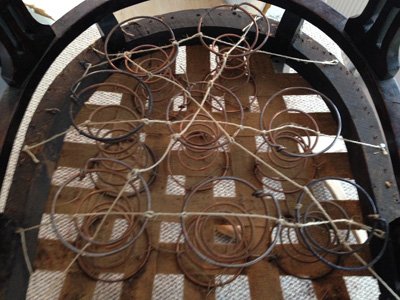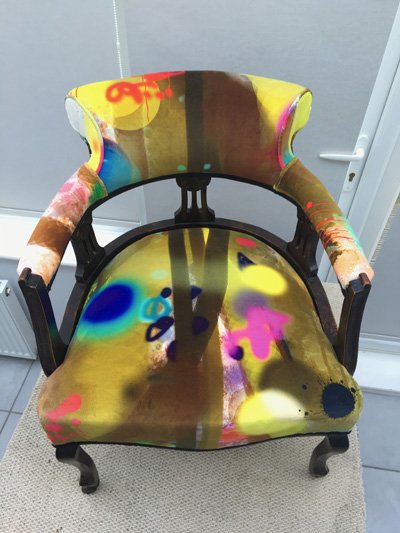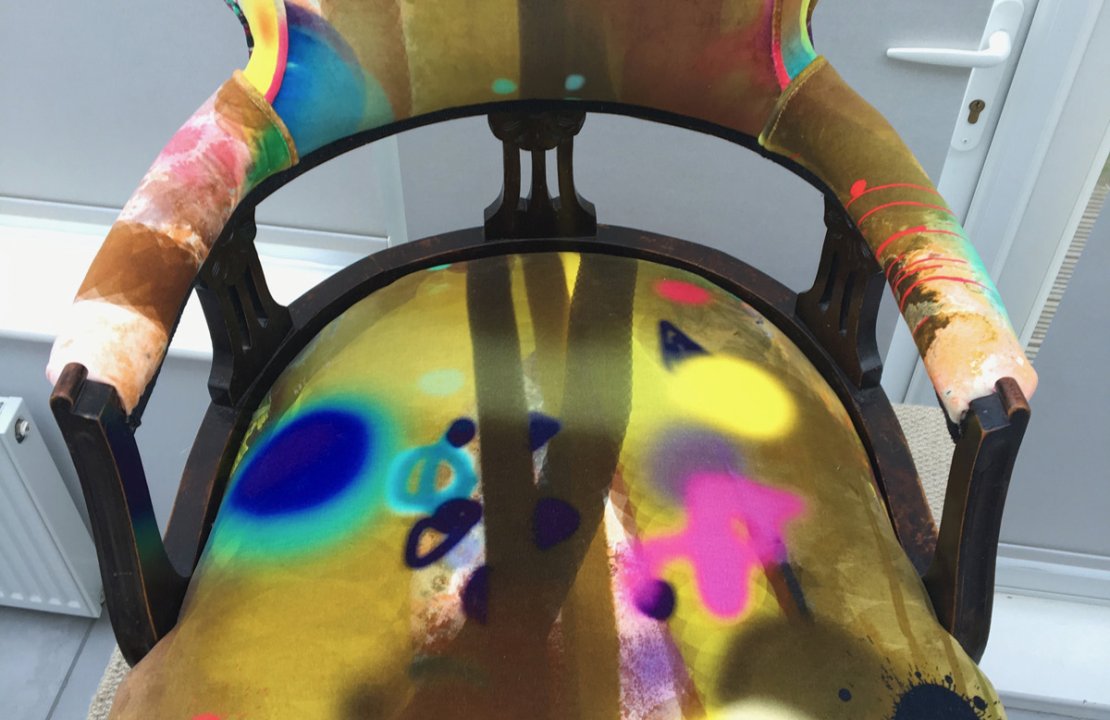The techniques of traditional upholstery are centuries old. To reupholster a chair, means to take the chair back to its frame and build the shape back up with springs, fibre, animal hair and hand stitching.
Using one of my chairs as an example, I will show the process without going into too much detail.
What's the first step to reupholstering a chair?
It’s always a good idea to see what has been done before. The chair’s seat was a little uneven, so the springs were probably loose. There was also a stitched edge on the front base. The scroll arms were created from fibre and hessian.
My first job was to strip the frame. Using a ripping chisel and mallet; I took the tacks out, working with the wood grain. A lot of antique frames can be weak, full of tack holes or even woodworm, so the frame needs to be strengthened first. Use wood glue and clamps to fix any joints. Fill old tack holes with wood glue mixed with fine sawdust. Rub onto the frame, leave to dry then gently sand frame down. Avoid sanding down the show wood, I only cleaned and revived it.

With a lot of chairs, it’s best to start with the scroll arms first, leaving the seat until last. This way, you can reupholster with the least amount of obstacles! Springs can get in the way, so leave them until last.
The scroll arms were created by fibre mostly, tacking webbing and hessian onto the frame. To start the fibre process, I created bridal ties on the hessian. These ties secured the stuffing whilst I manipulated the fibre. The fibre will form the support and shape and comfort of the whole chair. Placing the fibre in the loops, we covered the back and spent a lot of time teasing the fibre with my fingers, joining the handfuls of fibre together. This is an important part of the process. The fibre should be even, smooth and mixed together at the end of it. In this case, the scroll is not pleated but the fibre needs to be shaped to work with the faciers. When the fibre was finished, it was covered with calico.
Starting the seat I used large tacks and a tacking hammer to secure the webbing on the underside of the frame. Criss-crossing the webbing, creating a strong base for the springs. I re-used the original springs, putting them evenly over the webbing. The original springs, as shown, were unbalanced and the cord was loose.

With chalk, I drew around the base of the spring, to show a map of where the springs should sit, (in case they fall over in the sewing process). I used a curved or spring needle to attach the springs to the webbing, with a natural or nylon cord. Each spring had four knots and moved from one spring to the next.
The next stage was to lash the springs with laid cord. This process ensures the springs work correctly and don’t buckle or break. This chair requires a diagonal layout, ensuring all springs are lashed at right angles on each spring. The springs are kept under a certain amount of tension to stabilise the seat. Scrim is attached over the springs. Then I sewed the top of the springs to the scrim using natural cord once again.
Fibre was placed on top of the springs as explained above. The fibre was then covered with scrim and placed correctly over the frame. Ensuring the waft and weft is parallel with the frame. I temporarily tacked the scrim, to start the process of a stitched edge. Stuffing ties held the fibre in place whilst I worked on the stitched edge. The edge needed a lot more fibre, so with the stuffing ties in place, I took the temporary tacks out and added more stuffing, rolling over the scrim and permanently tacking down the scrim with fine tacks on the edge of the frame. Using a regulator, the fibre was teased outwards towards the edges, creating the desired shape. It’s important to follow the thread of the scrim when stitching. I chalked out stitch lines, starting from just above the tacks. If however there are curves in the frame, the thread lines will be distorted. Firstly, I created a line of blind stitching, using a bayonet double-pointed needle. After each stitch line, I regulated again. Top stitching at least two lines. The edges should feel harder than the inside of the seat.
Once the stitched edge was done, a second layer of bridal ties held a thin layer of mixed animal hair. This smoothed out any uneven areas the stitching or ties had caused. Skin wadding was placed over the hair, to ensure the hair did not poke through the fabric. My final step was to cover with calico, attached with tacks. The fabric was next.
I chose a dramatic, ultra modern fabric for this chair. The pattern is random, so it was a case of placing the pattern and seeing what looked balanced.
The scroll arms were attached in two steps. The central back area is covered first, tighten and tack. Hand sewing the piped side faciers on to finish. The arms were cut to fit, machine sewing the piping on first, then tack onto the arm frame.
How do you order the correct amount of fabric for reupholstery?
To measure and then place the seat fabric, width and length measurements need to be taken. I made sure there was enough fabric to go under the frame and through to the back, where it will be attached. The cuts around the seat frame need to be very accurate. Use a pin to find the exact area where the cut should be made. Work out where it will fold and cut. There are several ways to cut fabric. It’s a really important part of upholstery and making the wrong cut can impact the whole chair. You could do a practice run with cheap lining fabric before cutting the real thing if you are unsure.

Finally I hand-sewed a piece of the fabric on the back of the scroll arms.
The chair had a black braid placed around the show wood. This was fixed with a glue gun. Braid or gimp not only covers up the tacks but also puts a frame around the fabric.
The last part of the process is to fix a black bottom cloth on the underside of the seat, to cover the webbing. The chair is now beautifully restored.
This article has been written for us by an old friend of The Victorian Emporium, Claire Platten, who is a fabulous upholsterer based in East London.
Claire Platten studied Fine Art at University, had a successful career in marketing and graphic design before re-training as an upholsterer. Whilst working on furniture commissions, Claire also works on her own collections. Working with modern and traditional techniques, Claire puts her experience with design, colour and craft to produce unique pieces of furniture.
www.claireplatten.com

Be the first to add a comment...